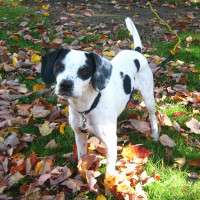Appearance of the Beaglemation
|
| The Beaglemation is a medium to large dog and a true canine athlete. They are muscular, with deep chests, tucked-up bellies and strong, straight legs. They have a long, whip-like tail that is likely to wag most of the time. The Beaglemation has a good-length muzzle and velvety floppy ears that sit high on the head and drop to or below the chin. Both parent dogs have short coats, and the Beaglemation is no different. The main background color of the coat is white, and they may wear a variation of either parent's coat, ranging from Dalmatian polka dots to Beagle spots in colors such as black, pale yellow, brown and brindle. |
Temperament of the Beaglemation
|
| Both parent breeds are renowned for their dynamism, as befits dogs with a working heritage. It therefore follows that the Beaglemation is a highly energetic dog requiring almost constant mental activity and stimulation. In fact, they could also be described as strongly related to certain Dalmatians with a characteristic trait of nervousness and anxiety. Not only do they crave physical exercise, but their minds need to be occupied too. Unfortunately, a bored Beaglemation will create its own entertainment, which probably involves barking, chewing, destructive behavior or all three. |
Needs and activities of the Beaglemation
|
| The Beaglemation is typically a fun, affectionate creature that makes an excellent family companion. They get on well with adults and children alike, although they are known to be a little stubborn during training. Due to their Dalmatian nature, this hybrid can tend to become very aggressive or destructive if not given enough attention or socialized properly. Although these dogs have a lot of energy, they are also quite capable of focusing that energy and will benefit from advanced training techniques to keep their minds and bodies busy. Beaglemation will generally get along with other dogs, but they may not be able to resist the pursuit of small, fast-moving animals like cats. Both Beagles and Dalmatians have a reputation for being clowns on occasion, and their offspring are no exception, seemingly enjoying making their family laugh with their frolics. |
Maintenance of the Beaglemation
|
| This particular combination of dog breeds makes them easy to care for. Although the Beagle side can contribute to a slight doggy smell, these dogs are generally very clean and only require a bath every few months. Their short coats are not prone to matting or clumping. Brushing is therefore only necessary every few days to a week to remove loose hairs and keep the coat soft and smooth. Dogs with floppy or hanging ears may be a little more susceptible to ear infections. Checking and cleaning the ears should therefore be part of their grooming program. |









 English (United Kingdom)
English (United Kingdom)